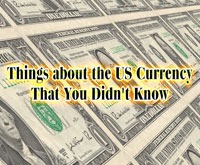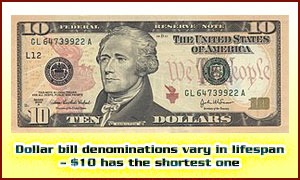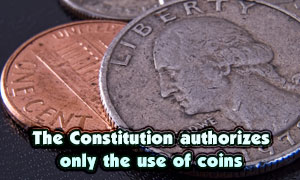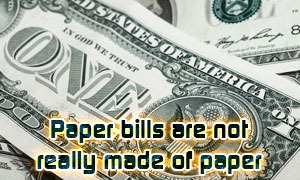The United States is one of the most economically powerful countries in the world, and that is why the US dollars become the basis for most global transactions made. You may use money a lot but you probably do not give much thought about money, except for lamenting about the lack of it, or where to spend, save or invest it. But there are things about the US dollar that you didn’t know that are interesting enough to share to your peers.

1. Dollar bill denominations vary in lifespan –$10 has the shortest one.
For non-living things like money, lifespan ends when it can’t be functional anymore. The $10 dollar bill has the shortest life expectancy as it would fall out of circulation for about 4.5 years, according to 2013 data from Federal Reserve Bank. The estimated lifespans of a $1 and $5 bill are 5.8 years and 5.5 years, respectively. The $20 bill lasts longer for about 7.9 years, and the $50 bill normally survives 8.5 years. The $100 bill has the highest lifespan was calculated to about 15 years.
 2. The Constitution authorizes only the use of coins.
2. The Constitution authorizes only the use of coins.
In Article I of the Constitution, use of paper currency was not mentioned. It states that the federal government has the sole power to “coin money” and “regulate the value thereof.” At the time the Constitution was written, it was easy to make counterfeit bills, and those bills issued by the Continental Congress to fund the American Revolution, or continentals, had no value after the end of the war. The implosion of the continental caused the government to lose faith in paper currency. However, the expense of the Civil War triggered the government to create paper money again in July 1861.
 3. Paper bills are not really made of paper.
3. Paper bills are not really made of paper.
Trees are not sacrificed for Americans to have money. Dollar bills are made up of 75% cotton and 25% linen. That is why a dollar bill still looks like a dollar bill even after being trapped in a pocket of a pair of jeans that was washed through the laundry machine.
4. No living person’s face has been placed on US money.
The United States, just like most countries in the planet, has people on its money. But unlike others who depict the current king or queen, or a leader in their money, America avoids putting a person currently in place of power on its bank note. It is because ever since gaining independence from the British Empire, the US wanted to make it clear that it is a country that will never be ruled again by any sort of monarchy – and the money is one way to illustrate that stand. The law ordering this was passed during the American Revolution and is still effective today. One exception to the rule was when President Calvin Coolidge’s face was placed on a coin in 1926 to commemorate the 150th year of independence of the US.
5. The Secret Service was initially created to deal with counterfeit money.
The Secret Service is an agency whose job is to protect the president and other top political leaders to keep them and their family safe and alive. It is part of the Department of Homeland Security since 2003, but it was under the Department of Treasury since 1865 as a special division created to crack down counterfeiting money. When the Secret Service was established, it was reported that one-third of the currency in circulation were fake, and they were tasked to keep the treasury secure. The agency is still fighting bogus money today but it is more known today for its agents wearing dark suits in intimidating SUVs. Ironically, the legislation to create the agency was on President Abraham’s Lincoln desk the night he was assassinated in 1865. The Secret Service assumed full responsibility to protect the president full-time after the assassination of President William McKinley in 1901.
 6. Mutilated dollar bills are still redeemable.
6. Mutilated dollar bills are still redeemable.
If you think that a torn, mutilated or even ripped and an incomplete dollar bill is worthless, you are wrong. You can tape two parts of a dollar bill and a bank will replace it. Even if you have a ripped bill, you can still be able to exchange it for a whole one as long as you have 50% of it.
 7. Money is full of dangerous bacteria, as well as traces of drugs.
7. Money is full of dangerous bacteria, as well as traces of drugs.
We all know that money is literally dirty, but did you know that it can cause pneumonia or staphylococcus infections? A 2002 study by the US Air Force found that 94% of dollar bills had presence of dangerous pathogens. But bacteria is not the only nasty stuff that can be found in dollar bills – a 2009 study showed that 90% of US bills in cities contained trace of cocaine in it. In fact, the presence of the drug was discovered 100% out of money from the following cities: Boston, Detroit, Miami, Los Angeles and Orlando.
8. The largest US dollar denomination ever issued was $100,000.
The largest dollar bill produced by the US Bureau of Engraving and Printing was the $100,000 gold certificate released on December 18, 1934, with a portrait of President Woodrow Wilson printed on the obverse. The currency was printed only until January 9 the following year and was never circulated to the public due to the risk associated with so much value allocated to a single bill. The money was used exclusively for transactions among Federal Reserve banks.
9. The highest denomination issued to the public did not feature a president.
The highest denomination ever circulated by the federal government was the $10,000 bill, and it was not printed with a portrait of a president – it was adorned with a photo of Salmon P. Chase, the treasury secretary at the time the National Banking Act was passed. The bill was discontinued in 1969, as well as $5,000, $1,000 and $500 bills.
10. The two-dollar bill is still in active circulation.
Some people get to treasure their $2 bill, thinking it had more value due to its rarity. But actually, it is still priced at $2 due because it is still actively used in public circulation. The current version of the bill, which was printed since 1976, had 1.2 billion pieces in people’s possession in 2016.
11. Coins from other countries were once acceptable legal tender in the US.
Today, it is currently illegal to use coins from other country as currency, but that wasn’t always the case. Before silver and gold were discovered in the West during the mid-1800s, there was lack of precious metals that can be used to create coins. A 1793 law allowed Spanish dollars and other foreign currencies as part of the monetary system in the US. They were banned as legal tender in 1857.
12. The design of the one-dollar bill is the oldest in circulation.
Since 1963, the $1 bill has not changed its design. No new design research and change has been made to the denomination for a long time because it is rarely counterfeited, so it is not a problem anymore for the Federal Reserve and Bureau of Engraving and Printing.



 2. The Constitution authorizes only the use of coins.
2. The Constitution authorizes only the use of coins. 3. Paper bills are not really made of paper.
3. Paper bills are not really made of paper. 6. Mutilated dollar bills are still redeemable.
6. Mutilated dollar bills are still redeemable. 7. Money is full of dangerous bacteria, as well as traces of drugs.
7. Money is full of dangerous bacteria, as well as traces of drugs.